Coronado National Forest
- February 2, 2024
- 0 comment
Explore the diverse landscapes of Coronado National Forest, spanning deserts to mountains, with endless hiking, camping, and wildlife viewing opportunities. Located in the heart of the Southwest, the Coronado National Forest offers a unique blend of natural beauty and recreational activities that beckon adventurers and nature lovers alike. From the sprawling deserts dotted with saguaros to the lofty peaks shrouded in pines, this forest spans a variety of ecosystems, each offering its own distinct charm and adventure opportunities.
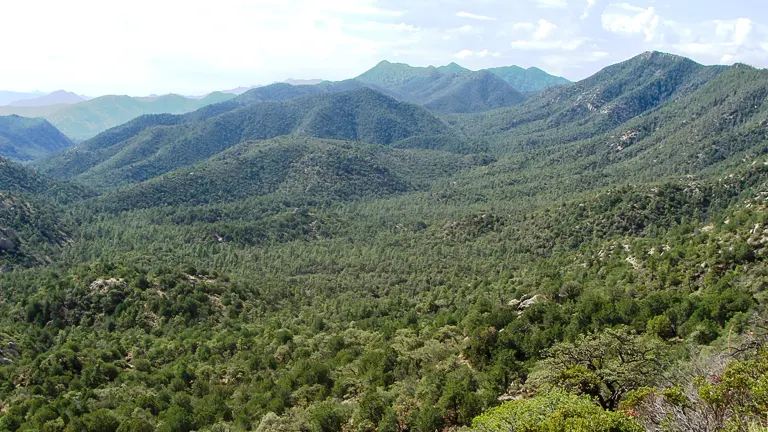
Whether you’re drawn to the challenge of its rugged trails, the tranquility of its remote camping sites, or the thrill of spotting wildlife in their natural habitat, Coronado National Forest is a haven of outdoor exploration. With endless hiking, camping, and wildlife viewing opportunities, it embodies the spirit of adventure and the beauty of the American Southwest.
Characterizing Features of Coronado National Forest
- Diverse Landscapes: Coronado National Forest is distinguished by its remarkable variety of landscapes, encompassing everything from arid deserts with iconic saguaro cacti to lush, high-elevation forests blanketed in pines, firs, and aspens. This diversity not only creates a visually stunning mosaic of habitats but also supports a wide range of recreational activities. Visitors can experience the dramatic shifts in ecosystem within a single day’s journey, making the forest a unique destination for those interested in the natural world’s complexity and beauty.
- Sky Islands: The concept of “sky islands” is central to the character of Coronado National Forest. These are isolated mountain ranges that rise abruptly from the surrounding desert plains, creating elevated havens for diverse species and ecosystems. The sky islands of Coronado are biodiversity hotspots, offering refuge for species that would otherwise face geographic isolation. These unique formations contribute to the forest’s status as a place of significant ecological interest, providing critical habitats for a variety of plants and animals and offering spectacular views and hiking opportunities for visitors.
- Rich Biodiversity: The forest is a living showcase of biodiversity, thanks to its varied climates and elevations. It hosts an impressive array of flora and fauna, adapted to life in its distinct zones. This includes over a thousand plant species, from the desert’s agave and cactus to the high mountains’ conifers and deciduous trees, and hundreds of animal species, including rare and endangered ones. The rich biodiversity not only makes the forest a critical area for conservation efforts but also a fascinating place for nature observation and study.
- Cultural Heritage: Coronado National Forest is steeped in cultural history, reflecting centuries of habitation by Native American tribes, Spanish explorers, and American settlers. The landscape is dotted with archaeological sites, historic mining towns, and remnants of old homesteads, telling the stories of those who lived and worked in the area. These sites offer a glimpse into the human history intertwined with the forest’s natural history, enriching the visitor experience with a sense of continuity and connection to the past.
- Recreational Opportunities: With its diverse environments, the forest caters to a wide range of outdoor activities, making it a premier destination for recreation in the American Southwest. Hiking, camping, bird watching, and mountain biking are just a few of the activities that draw people to Coronado National Forest. The availability of such a variety of recreational opportunities, combined with the scenic beauty of the area, underscores the forest’s role as a place of leisure, adventure, and connection with nature.
- Conservation and Research: Coronado National Forest plays a vital role in conservation and environmental research. It serves as a living laboratory for scientists studying ecology, climate change, and conservation biology. Efforts to manage the forest sustainably ensure the protection of its resources and the well-being of its ecosystems. Projects involving habitat restoration, fire management, and species protection are ongoing, demonstrating the forest’s importance as a site for both preserving biodiversity and understanding ecological processes.
History of Coronado National Forest
Coronado National Forest’s history is a rich tapestry woven from the threads of natural evolution, indigenous habitation, exploration, and conservation efforts. Established in 1902, the forest was named in honor of Francisco Vásquez de Coronado, a Spanish explorer who, in the 1540s, led a significant expedition in search of the mythical Seven Cities of Gold, traversing much of the area that today comprises the forest. This historical designation reflects the forest’s deep connections to both the natural world and the human narratives that have unfolded across its landscapes. Over centuries, it has been home to diverse indigenous peoples, whose stewardship of the land has left a lasting imprint on the forest’s ecology and cultural heritage. Their knowledge and practices have contributed to the rich biodiversity and ecological complexity that the forest is known for today.
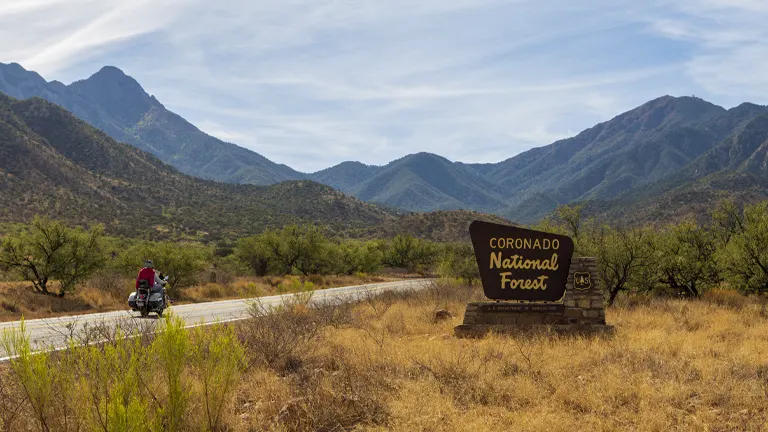
In the early 20th century, the United States government recognized the need to preserve and protect the unique environments within Coronado National Forest, marking the beginning of its formal conservation. The enactment of the Forest Reserve Act of 1891 laid the groundwork for the establishment of national forests, including Coronado, to conserve water resources, provide timber, and ensuring the sustainable use of the land. Over the years, the forest has seen various conservation efforts, including fire management practices, wildlife protection initiatives, and habitat restoration projects, all aimed at preserving its natural beauty and ecological integrity for future generations. Today, Coronado National Forest stands as a testament to the ongoing commitment to environmental stewardship, recreation, and the preservation of America’s natural and cultural history.
Unique Ecosystem of Coronado National Forest
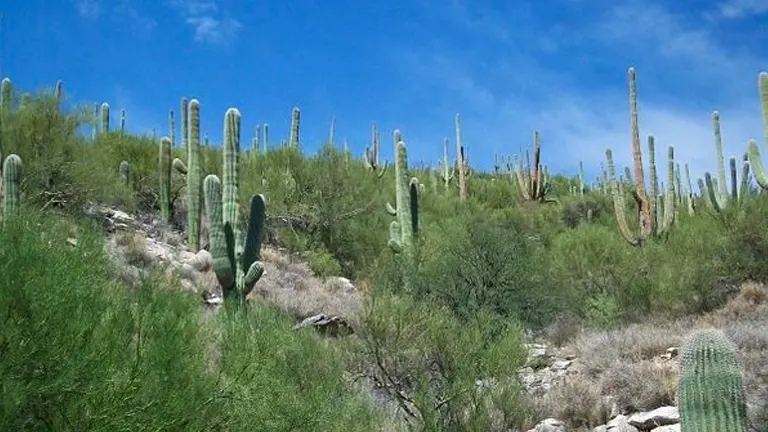
The Coronado National Forest is celebrated for its unique ecosystem, characterized by the remarkable “sky islands”—mountain ranges that rise dramatically from the surrounding desert lowlands, creating isolated habitats with a diversity of life that is rare and eclectic. This phenomenon results in a mosaic of ecological zones, where desert flora and fauna coexist near alpine forests within a relatively short distance. These sky islands act as refuges for species by offering cooler, wetter conditions compared to the surrounding desert, facilitating a high degree of biodiversity. The varying elevations and climates within the forest support an array of ecosystems, from arid deserts dotted with cacti to lush pine and fir forests at higher altitudes. This diversity not only makes Coronado a hotspot for scientists studying ecology and conservation but also turns it into a unique destination for nature enthusiasts eager to experience the stark beauty and rich biodiversity of the American Southwest.
Location of Coronado National Forest
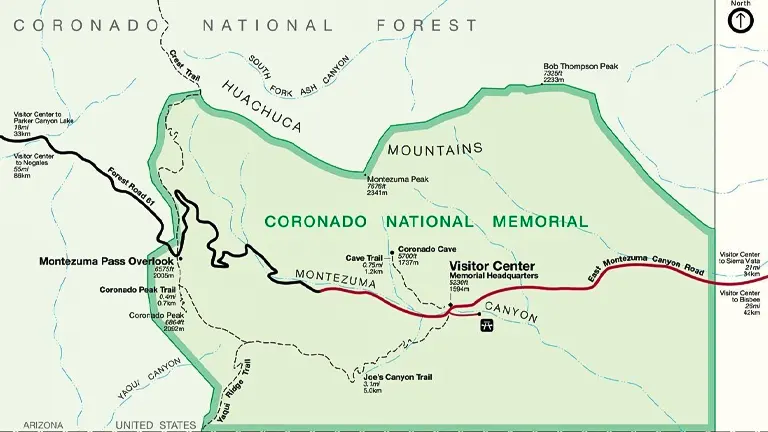
Straddling southeastern Arizona and into the southwestern part of New Mexico, Coronado National Forest covers an expansive area marked by its stunning sky islands and desert landscapes. The forest’s boundaries encompass a significant portion of the Madrean Archipelago, with elevations ranging from 3,000 to 10,000 feet. Its location offers not only a dramatic backdrop for outdoor activities but also serves as a critical habitat for a myriad of species.
Here’s a list of guides for accessing Coronado National Forest:
1. Via Tucson for Santa Catalina Mountains:
- Start in Tucson, AZ.
- Take the Catalina Highway off Tanque Verde Road.
- Follow signs to Mount Lemmon. The scenic byway offers direct access to hiking trails, campgrounds, and ski areas in the Santa Catalina Mountains.
2. Via Sierra Vista for Huachuca Mountains:
- Begin in Sierra Vista, AZ.
- Access the Huachuca Mountains via AZ-90 S.
- Turn onto Coronado National Memorial Road to explore the southern sections or use Ramsey Canyon Road for northern access points.
3. Via Willcox for Chiricahua Mountains:
- Start from Willcox, AZ.
- Take AZ-186 E towards the Chiricahua National Monument.
- Continue on to Pinery Canyon Road for access to Chiricahua Wilderness Area and various trailheads.
4. Via Safford for Pinaleno Mountains (Mt. Graham):
- Begin in Safford, AZ.
- Take US-191 S/US-70 W.
- Turn onto AZ-366 (Swift Trail) leading up to Mt. Graham for high elevation hiking and camping.
5. Public Transportation Options:
- While public transportation may not directly access the forest, Tucson serves as a hub for reaching the outskirts of the Santa Catalina district. From there, car rentals or local shuttle services can provide closer access.
6. Seasonal Road Closures:
- Be aware of seasonal road closures, especially in higher elevations during winter months. Check the Coronado National Forest website or contact local ranger stations for current conditions.
7. Using GPS and Forest Maps:
- While GPS is helpful, relying on updated forest maps for trailheads and specific areas within the forest can ensure accurate navigation, especially in remote areas where signal may be limited.
The Importance of Conservation and Recreation in Coronado National Forest
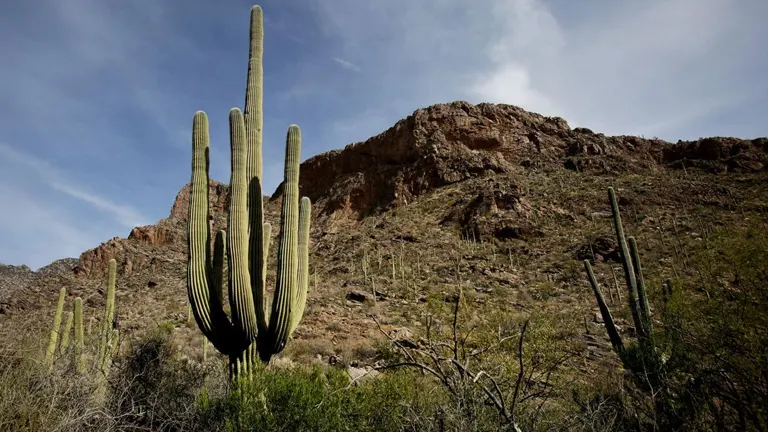
Coronado National Forest serves as a prime example of how conservation efforts can coexist harmoniously with recreational use. The forest’s management practices are designed to protect its natural resources, including water quality, wildlife habitats, and plant communities, while accommodating millions of visitors each year. Recreational activities are carefully regulated to ensure they do not compromise the health of the forest’s ecosystems. Trails, campsites, and facilities are maintained with sustainability in mind, ensuring that future generations can enjoy the forest’s natural beauty just as we do today. Conservation initiatives, including reforestation projects and habitat restoration, are critical in preserving the unique biodiversity of the forest.
Diverse Vegetation and Plant Species in Coronado National Forest
- Saguaro Cactus (Carnegiea gigantea): Emblematic of the Sonoran Desert, these towering cacti are not just iconic landscape features but vital habitats for birds like the Gila woodpecker and provide moisture for many desert dwellers.
- Ponderosa Pine (Pinus ponderosa): Dominating the higher elevations, these trees form extensive forests, offering shade and cooler temperatures, significantly altering the environment from the desert below.
- Douglas Fir (Pseudotsuga menziesii): Found in the cooler, moist areas of the highest elevations, Douglas firs contribute to the forest’s diversity, providing habitat for numerous wildlife species and contributing to the forest’s complex ecosystem.
- Ocotillo (Fouquieria splendens): This desert plant, known for its long, spiny stems and vibrant red flowers, thrives in the arid lower elevations of the forest, adding bursts of color to the landscape after rainfall.
- Manzanita (Arctostaphylos): With its distinctive red bark and green leaves, manzanita bushes are common in the chaparral and woodland areas, providing food and shelter for wildlife and contributing to the biodiversity of the forest.
- Alligator Juniper (Juniperus deppeana): Recognizable by its thick, checkered bark resembling alligator skin, this juniper species is found in various elevations, offering berries that are an important food source for birds and mammals.
- Mexican Blue Oak (Quercus oblongifolia): A resilient species adapted to dry, rocky soils, the Mexican blue oak adds to the forest’s arboreal diversity, showcasing the adaptability of plant life in varying climates and elevations.
- Riparian Vegetation: Along streams and rivers, riparian zones flourish with a variety of plant species, including willows (Salix) and cottonwoods (Populus), creating lush corridors of greenery that contrast with the surrounding arid landscapes. These areas are crucial for ecosystem health, supporting a wide range of species and stabilizing stream banks.
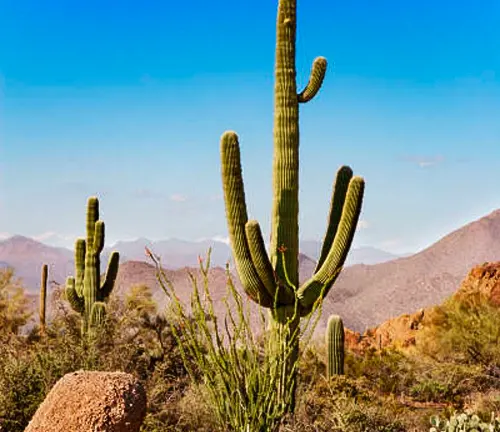
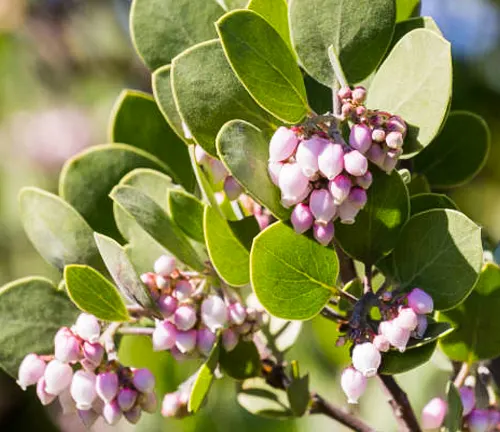
Fauna in Coronado National Forest
- Mexican Spotted Owl (Strix occidentalis lucida): Listed as a threatened species, this owl prefers the dense canopy of old-growth forests. Its presence indicates healthy forest ecosystems and serves as a key species for conservation efforts within the forest.
- Javelina (Pecari tajacu): Also known as the collared peccary, javelinas are commonly found in both desert and riparian areas. These social animals travel in herds and are well-adapted to the arid conditions of the Southwest.
- Gila Monster (Heloderma suspectum): One of the only venomous lizards in the United States, the Gila monster is often found in desert scrub and woodland areas. Its bright colors warn predators of its venomous bite, a rare but fascinating sight for visitors.
- Coati (Nasua narica): Belonging to the raccoon family, coatis are curious and adaptable creatures. They are often seen in groups, foraging through various forest layers from ground level to treetops, particularly in the forest’s southern regions.
- Elk (Cervus canadensis): Introduced to the region, elk have thrived in the higher elevations, where meadows and open forests provide ample grazing. Their bugles echo through the forest in the fall, a haunting sound of the wild.
- Black Bear (Ursus americanus): As the only bear species present in the area, black bears are a symbol of wilderness in Coronado National Forest. They inhabit various forested environments, adapting their diet and behavior to the changing seasons.
- Peregrine Falcon (Falco peregrinus): The world’s fastest bird, the peregrine falcon, can be spotted in the sky islands, diving for prey at incredible speeds. Its presence signifies the health of the forest’s avian populations and the success of conservation efforts.
- Arizona Treefrog (Hyla wrightorum): The state amphibian of Arizona, this small treefrog, is often found near water sources in wooded areas. Its distinctive call fills the night air during the rainy season, contributing to the forest’s biodiversity.
- Chiricahua Leopard Frog (Lithobates chiricahuensis): This species is of particular conservation concern, found in aquatic habitats within the forest. Efforts to preserve its dwindling populations are crucial for maintaining ecological balance in wetland areas.
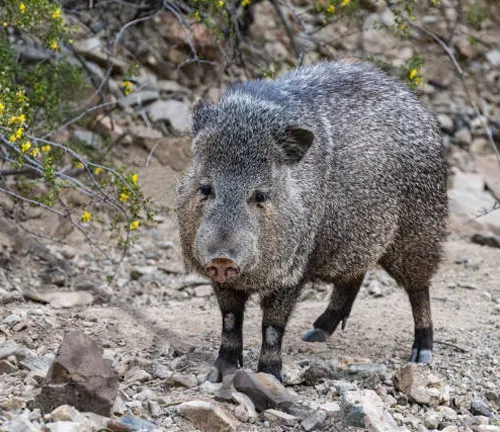
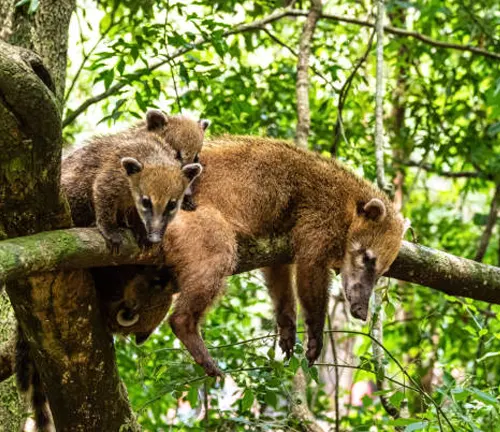
Attractions in Coronado National Forest
Sky Islands Scenic Byway (Catalina Highway): This scenic drive winds its way from the desert floor up to the cool heights of Mount Lemmon, offering breathtaking views of the desert below and access to numerous hiking trails, picnic areas, and campgrounds. The dramatic change in vegetation and climate along the drive showcases the unique ecological concept of sky islands, making it a must-visit for anyone exploring the Coronado National Forest.
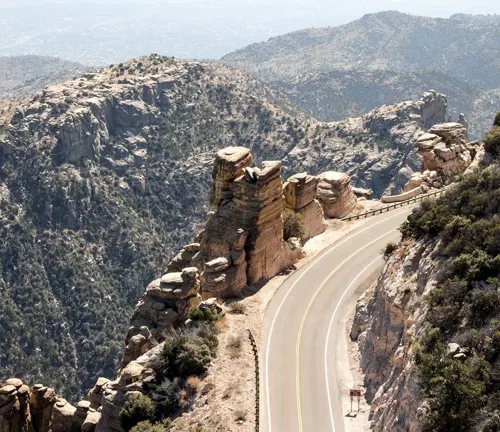
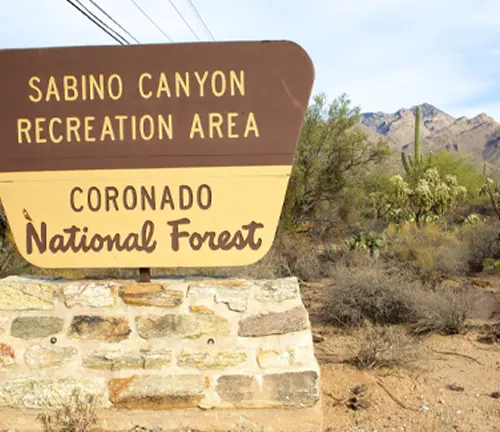
Sabino Canyon: Located in the Santa Catalina Mountains, Sabino Canyon is a natural desert oasis fed by spring waters and seasonal rains. Visitors can explore this stunning landscape through a network of hiking trails or enjoy a narrated tram ride, which offers insights into the canyon’s natural and cultural history. Its accessibility and beauty make it a popular spot for both locals and tourists.
Chiricahua National Monument: Often referred to as the “Wonderland of Rocks,” this area within the Coronado National Forest is famous for its extensive rock formations and spires that have been sculpted over millions of years by volcanic activity and erosion. Hiking trails meander through the fantastical landscape, providing opportunities for photography, bird watching, and immersing oneself in the tranquility of nature.

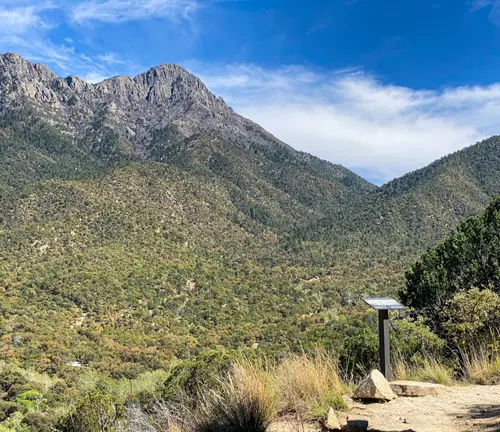
Madera Canyon: A renowned birdwatching hotspot, Madera Canyon is nestled in the Santa Rita Mountains. It offers a range of trails that cater to all levels of hikers, from leisurely walks to challenging hikes. The diverse habitats within the canyon support an impressive variety of bird species, making it a globally recognized destination for birders.
Mt. Graham International Observatory: Situated atop Mt. Graham in the Pinaleno Mountains, the observatory is one of the world’s leading astronomical observatories. While access to the observatory itself is limited, the drive up Mt. Graham provides stunning views and the chance to experience the rich biodiversity of the sky islands, from desert scrub to alpine forests.
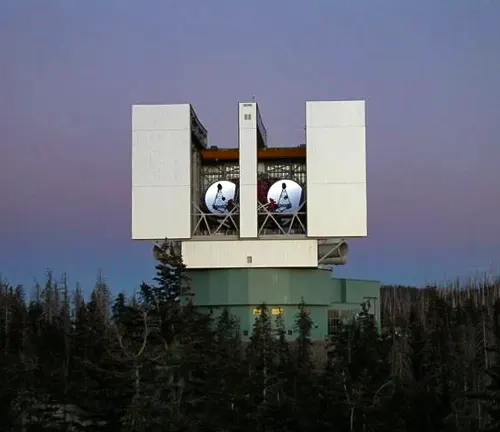
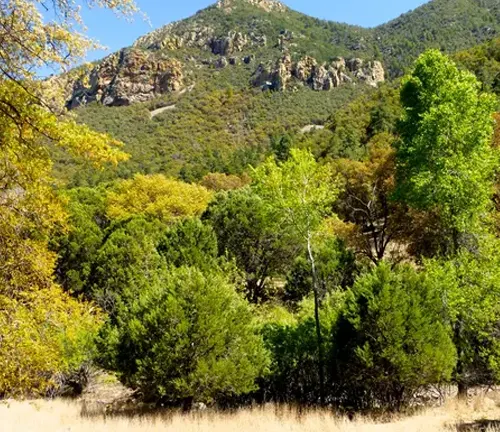
Ramsey Canyon Preserve: Managed by The Nature Conservancy, Ramsey Canyon is known for its exceptional biodiversity. The preserve is home to a variety of wildlife, including hummingbirds, and offers a peaceful retreat into nature with its gentle trails and riparian habitat. The cooler, moist conditions in the canyon support a lush array of plant life, contrasting sharply with the surrounding desert.
Coronado Cave: Offering a more adventurous attraction, Coronado Cave is a hidden gem that allows visitors to explore beneath the earth’s surface. The cave is accessible via a short hike and provides a glimpse into the geological history of the area. No special permits or equipment are required for entry, but visitors should bring flashlights and wear sturdy shoes.
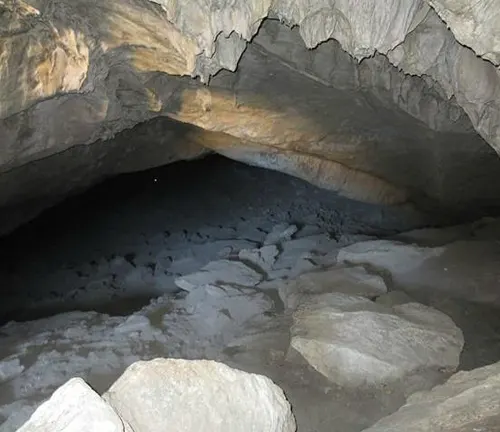
Recreational Activities in Coronado National Forest
- Hiking: With hundreds of miles of trails crisscrossing its diverse landscapes, hiking is one of the most popular activities in Coronado National Forest. Trails range from easy, family-friendly walks to challenging backcountry treks that lead to high peaks, deep canyons, and secluded spots. The forest’s extensive trail system allows visitors to explore the unique ecosystems of the sky islands, encounter wildlife, and enjoy panoramic views.
- Camping: Coronado National Forest offers a wide range of camping experiences, from developed campgrounds with amenities to primitive backcountry sites. Camping allows visitors to immerse themselves in the tranquility of the forest, whether setting up a tent under a canopy of stars in the desert or beside a bubbling stream in a mountain meadow. It’s an opportunity to disconnect from the hustle and bustle of daily life and connect with nature.
- Bird Watching: The forest’s diverse habitats are a haven for birdwatchers, hosting an impressive array of bird species, including rare and migratory birds. Areas like Madera Canyon and Ramsey Canyon are renowned for their birding opportunities, offering the chance to spot hummingbirds, warblers, and even elusive species like the Elegant Trogon. The varied elevations create unique environments that support a rich biodiversity, making Coronado National Forest a premier destination for bird enthusiasts.
- Mountain Biking: For those seeking an adrenaline rush, the forest’s network of trails also caters to mountain bikers. Ranging from gentle rides through rolling hills to challenging routes with steep climbs and descents, the trails offer something for riders of all skill levels. Mountain biking in Coronado National Forest provides a unique way to cover more ground and experience the stunning landscapes from a different perspective.
- Picnicking: With numerous picnic areas scattered throughout its expanse, the forest is a perfect spot for a leisurely lunch amidst nature’s beauty. Many picnic sites offer tables, grills, and access to trails, making it easy to enjoy a meal with family and friends followed by an exploration of the surrounding area. It’s a simple yet delightful way to appreciate the forest’s natural splendor.
- Wildlife Viewing: The varied ecosystems within Coronado National Forest support a wealth of wildlife, offering ample opportunities for viewing. From observing javelinas and deer in their natural habitats to spotting black bears or the elusive mountain lion from a safe distance, wildlife viewing is a rewarding activity for nature lovers. The forest’s “sky islands” are particularly rich in biodiversity, providing habitats for many species that are unique to the region.
- Astronomy: Thanks to its remote locations and high elevations, the forest offers some of the best stargazing opportunities in the Southwest. The clear, dark skies away from city lights are ideal for observing stars, planets, and meteor showers. Mt. Graham International Observatory, although with limited public access, underscores the area’s significance for astronomical observation. Amateur astronomers and casual stargazers alike can find numerous spots within the forest to marvel at the night sky.
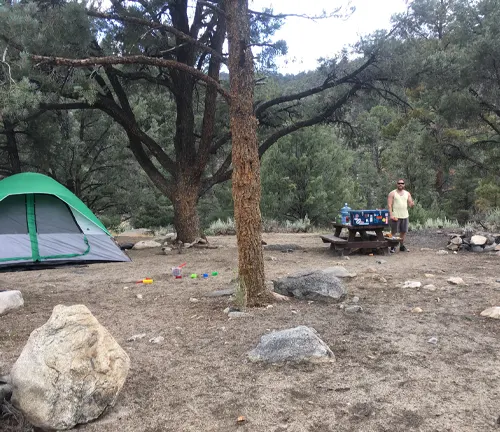
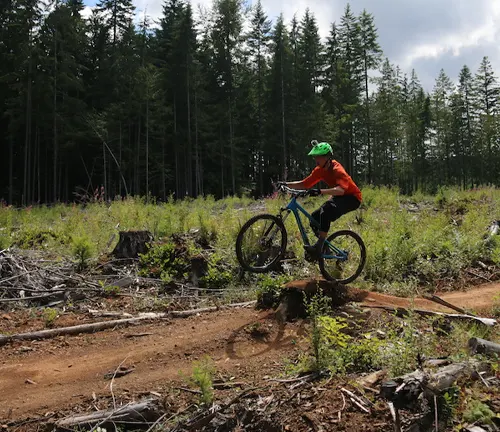
Different Facilities and Amenities in Coronado National Forest
- Campgrounds: The forest boasts a range of campgrounds, from developed sites with modern amenities such as restrooms, picnic tables, and fire rings, to primitive areas for those seeking a more rugged outdoor experience. Campgrounds are situated in various environments across the forest, allowing visitors to choose their preferred setting, whether it’s under the towering pines of high-elevation forests or in the expansive landscapes of the desert.
- Picnic Areas: Scattered throughout the forest are numerous picnic areas, many of which are located near trailheads, scenic overlooks, or alongside streams and rivers. These areas are equipped with tables and, in some cases, grills, making them perfect spots for families and groups to enjoy meals with a view. Picnic areas serve as convenient starting points for a day of exploration or a peaceful break during outdoor adventures.
- Trails: Coronado National Forest features an extensive network of trails catering to all levels of outdoor enthusiasts, from easy walks to challenging hikes. Trails are well-marked and offer access to the forest’s diverse landscapes, including scenic vistas, riparian zones, and unique geological formations. Informational signage along some trails enhances the educational experience, providing insights into the area’s ecology, geology, and history.
- Visitor Centers: The visitor centers in Coronado National Forest are invaluable resources for guests. Staffed by knowledgeable personnel, these centers offer maps, brochures, and information on the forest’s flora, fauna, and recreational opportunities. They can also provide updates on trail conditions, weather forecasts, and safety tips, making them a must-visit for those planning to explore the forest.
- Observation Sites: For those interested in photography, bird watching, or simply enjoying panoramic views, the forest offers several observation sites and overlooks. These spots are strategically located to showcase the forest’s stunning landscapes and biodiversity hotspots, providing visitors with unforgettable views of the surrounding mountains, valleys, and sometimes even wildlife.
- Restrooms and Sanitation Facilities: Developed areas within the forest, including many campgrounds and picnic areas, are equipped with restrooms and sanitation facilities. These amenities vary from flush toilets in some of the more developed sites to vault toilets in remote areas, ensuring that visitors have access to basic comforts while enjoying the natural environment.
- Informational Signage: Throughout Coronado National Forest, informational signage plays a crucial role in enhancing visitor experience and education. These signs offer insights into the local ecology, historical facts, trail guides, and safety information, helping visitors to navigate the forest safely while learning about their natural surroundings.
- Recreational Rentals and Concessions: In certain areas, visitors can find rental services for outdoor equipment, such as bicycles or binoculars, and concession stands offering snacks and refreshments. These services vary by location and season but contribute to making the forest more accessible and enjoyable for a wide range of visitors.
Tips and Advice for Visiting Coronado National Forest
- Check Weather and Road Conditions: The forest spans a wide range of elevations, leading to varied weather conditions. Before your visit, check the forecast for the specific area you plan to explore. Additionally, road conditions can change, especially in higher elevations or after weather events, so verify accessibility, particularly if planning to visit more remote areas.
- Respect Wildlife: The diverse habitats in Coronado National Forest are home to a variety of wildlife. While observing animals in their natural setting can be a highlight of your visit, it’s important to maintain a safe distance, not feed wildlife, and store food properly to avoid attracting animals to campgrounds and picnic areas.
- Leave No Trace: Preserving the natural beauty and integrity of the forest is a collective responsibility. Follow Leave No Trace principles by packing out all trash, staying on designated trails to prevent erosion, and camping in established sites or areas where camping is permitted to minimize impact.
- Stay Prepared: Whether you’re going for a short hike or a multi-day backpacking trip, it’s crucial to be prepared. Bring sufficient water, sunscreen, a hat, and layers of clothing to adapt to changing conditions. A map, compass or GPS, and a basic first aid kit are also essential, even on well-marked trails.
- Fire Safety: Be aware of current fire restrictions, which can vary throughout the year based on conditions. If campfires are allowed, use established fire rings, keep fires manageable, and ensure they are completely extinguished before leaving. Portable cooking stoves are a good alternative and often permitted even when fires are not.
- Plan Your Activities: With so much to see and do, it’s helpful to plan your activities in advance. Consider the length and difficulty of trails, availability of camping sites, and any permits or fees required for certain areas. Visitor centers can be a great resource for recommendations and updates.
- Respect Cultural Sites: Coronado National Forest is rich in cultural history, with many archaeological sites and historical landmarks. Respect these areas by not disturbing artifacts or structures, and learn about the history and cultures that have shaped the region.
- Wilderness Safety: If venturing into wilderness areas, understand the challenges and responsibilities. These areas are managed to be minimally impacted by humans, meaning fewer amenities and signs. Familiarize yourself with wilderness ethics, and be prepared for self-sufficiency and navigation in more remote settings.
- Stay Informed: Regulations and available amenities can change. Visit the official Coronado National Forest website or contact local ranger stations for the most current information regarding closures, permits, and conditions.
Recommendation
For those seeking an immersive nature experience, Coronado National Forest offers an unparalleled diversity of landscapes and activities. Whether it’s hiking through a desert canyon, camping under a canopy of stars in a high elevation forest, or exploring historic sites, there’s something for every outdoor enthusiast.
Conclusion
Coronado National Forest stands as a testament to the beauty and diversity of the American Southwest. With its unique ecosystems, rich history, and plethora of recreational opportunities, it offers an invaluable resource for conservation, education, and enjoyment. As stewards of this precious land, it’s up to us to appreciate, protect, and preserve it for generations to come.
FAQs
- What is the best time of year to visit Coronado National Forest?
Spring and fall offer the most comfortable weather for exploring the forest, though each season has its own unique attractions. - Are there any fees to enter Coronado National Forest?
While entry to most of the forest is free, some areas may require a day-use fee or a pass for parking and facilities. - Can I bring my dog to Coronado National Forest?
Yes, dogs are welcome but must be kept on a leash in developed recreation areas and campgrounds for the safety of wildlife and other visitors. - What are some safety tips for hiking in the forest?
Always tell someone your plans, carry plenty of water, use sun protection, and be prepared for changes in weather and terrain. - Are there any restrictions on camping?
Yes, there are specific areas designated for camping, and some may require permits. Check the forest’s website for detailed regulations. - How can I volunteer or contribute to conservation efforts?
The forest offers volunteer opportunities ranging from trail maintenance to educational programs. Contact the forest service for more information. - What wildlife might I see in Coronado National Forest?
Depending on the area and time of year, you might see deer, javelinas, coatis, a variety of birds, and possibly even black bears. - Are there any guided tours available?
Yes, guided tours are available in some areas, offering insights into the forest’s ecology, history, and management.
Coronado National Forest is more than just a destination; it’s a vibrant, living landscape that invites exploration, reflection, and connection. Whether you’re drawn to its towering peaks, deep canyons, or the stories etched into its land, a visit to this majestic forest is a journey through the heart of nature’s diversity.

Benjamin Brooks
Forestry AuthorGreetings! I'm Benjamin Brooks, and my journey over the past 15 years has revolved around the fascinating realms of content creation, expertise in snow clearing, and the intricate world of lumberjacking and landscaping. What began as a simple curiosity about the natural world and heavy machinery has evolved into a passionate profession where my love for crafting words intertwines seamlessly with my lumberjacking and garden skills.

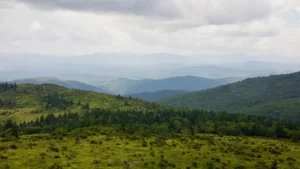


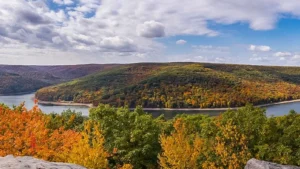

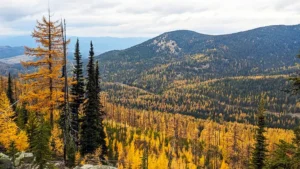
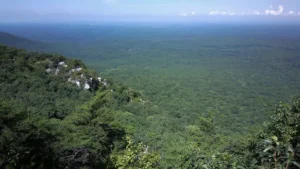


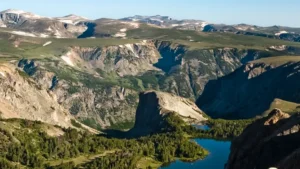

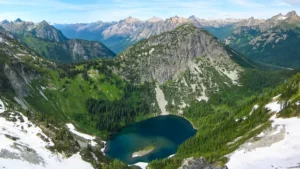
Leave your comment